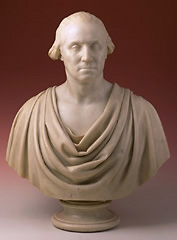Curriculum Materials: Art in America
|
|
Image 8 Hiram Powers Questions: |
Portrait Bust of George Washington
Powers based his bust of George Washington on a famous sculpture by the French artist Jean-Antoine Houdon. Houdon had studied the president firsthand, so his sculpture was considered one of the most accurate likenesses. Powers's portrait is at once idealized and naturalistic. Washington's strong nose, jowls, and wrinkles, as well as his stern expression, appear natural. In the Roman tradition of honoring the accomplishments of aging men in portrait busts, Powers stressed the president's maturity. The toga gracefully draped over Washington's shoulders conjures up images of venerable Greek nobles or Roman senators and raises the sculpture into the realm of idealism. The portrait becomes a SYMBOL of the "New Republic."
Through skillful chiseling and carving of a piece of
marble, Powers created the illusion
of various TEXTURES. The
heavy folds of the toga contrast with the smoothness of
Washington's flesh. His hair, pulled back off his high
forehead and gathered at the nape of his neck, appears soft.
Powers probably chose to work in
marble because so many of the most venerated art works from
ancient Greece and Rome were carved from this material. Not
knowing that most of the ancient sculptures were colorfully
painted in their original state, 19th-century artists and
patrons alike placed high value on the whiteness of marble.
They equated the whiteness with the nobility, rationalism,
and high purpose of their ancient predecessors.
|
|
